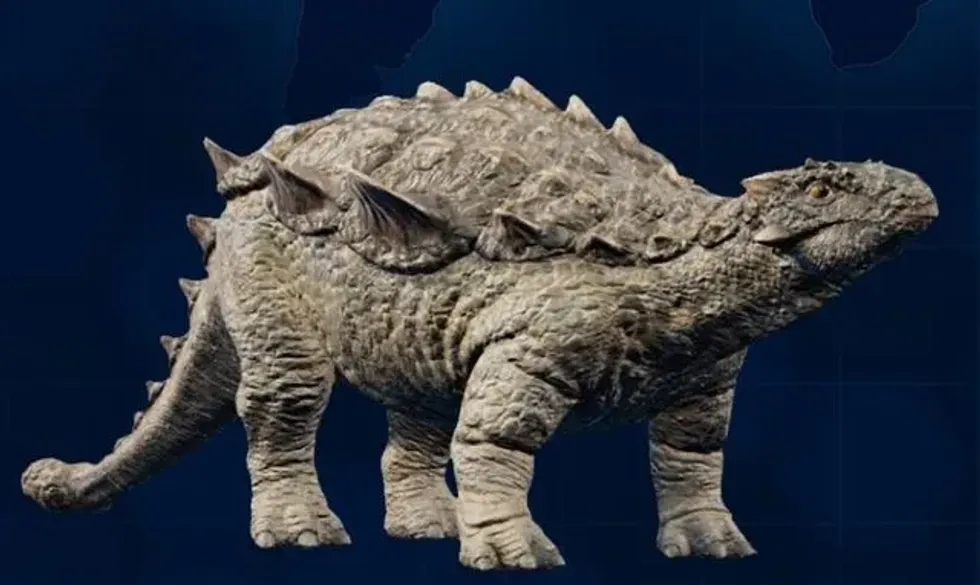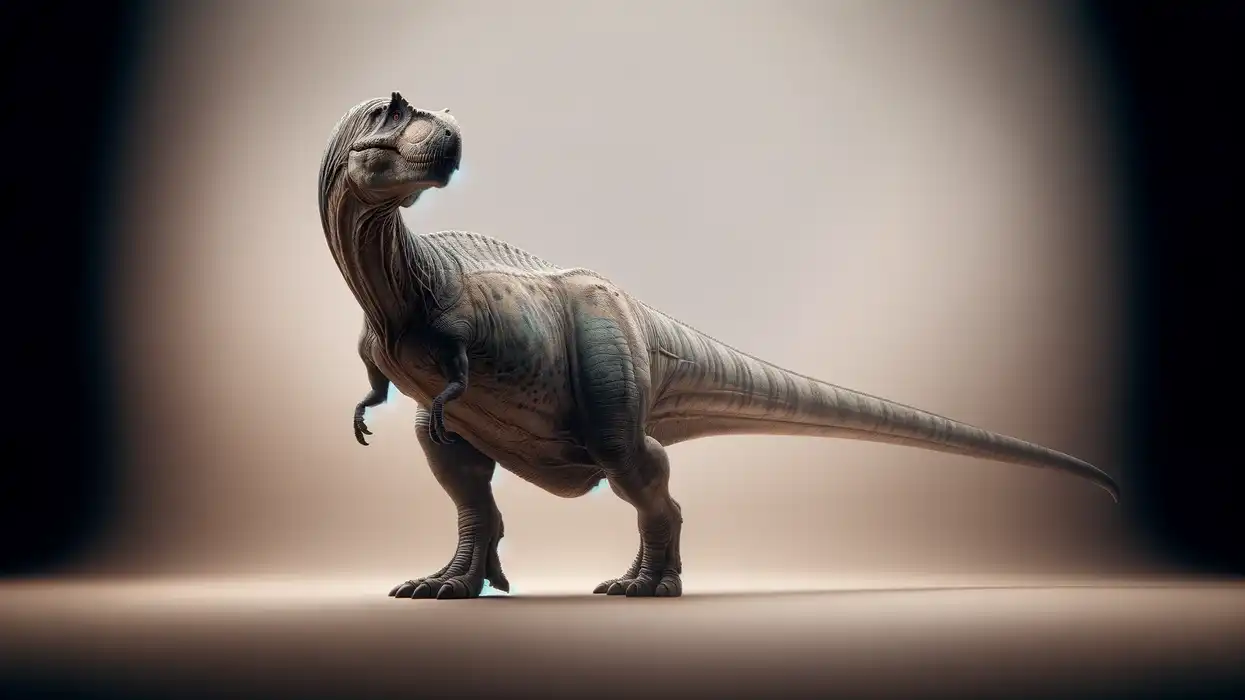Crichtonsaurus (Crichtonsaurus bohlini), of the genus Crichtonsaurus, was a herbivorous thyreophoran dinosaur from the Late Cretaceous period in the part of the world we now recognize as Northeast China.
The fossil remains were found sparsely distributed, which suggests that they lived together as social animals and had plenty to eat during their time there.
Crichtonsaurus was also discovered with fossils belonging to several other species such as Stegoceras validum (an iguanodontid ornithopod), indicating that these dinosaurs coexisted for at least part of their lives before individualizing again later on while migrating across different areas or regions where food supply may have changed either due to seasonal changes related vegetation growth/decline or when volcanic eruptions altered soil pH levels.
It is known for its bizarre, probably defensive, club-like tail and unusually long neck, as seen in the holotype that most likely enabled it to reach vegetation higher than other contemporary dinosaurs could access.
Crichtonosaurus was one of many similar types of dinosaurs called megalosaurs or 'big lizards.' The Crichtonsaurus was a large Cretaceous dinosaur that roamed the lands.
It had unusual armored plating on its neck, skull, and shoulders, which scientists speculate may have been for protection or to attract mates.
These dinosaurs were thought to have aggressive traits since they often fought with other dinosaurs in their territory over food sources and mating rights.
The late Cretaceous period of history produced some pretty interesting-looking dinosaurs in history such as the Ankylosaurid dinosaur (Crichtonsaurus bohlini).
This particular dino has an array of bony plates available throughout its body, including massive ones around its neck and back (called cervical osteoderms) as well as others down along it.
It had sharp teeth in the skull, which made it easy for them to eat plants back then, but they were likely frugivores as well (meaning their diet consisted of mostly fruit).
Find more relatable content by reading our Brontosaurus and Orodromeus facts for kids.
Crichtonsaurus Interesting Facts
How do you pronounce 'Crichtonsaurus'?
We all know how to pronounce 'Crichtonsaurus' because it is one of the most common dinosaur names in books and TV shows. It sounds like 'crick-ton-sore-us'!
What type of dinosaur was a Crichtonsaurus?
Crichtonsaurus (Crichtonsaurus bohlini) of the genus Crichtonsaurus was a type of herbivorous ankylosaurid, an armored dinosaur.
In which geological period did the Crichtonsaurus roam the earth?
In the Late Cretaceous period, dinosaurs such as Crichtonsaurus roamed Earth.
When did the Crichtonsaurus become extinct?
A Crichtonsaurus, or ankylosaurid dinosaur of the genus Crichtonsaurus, roamed the Earth and went extinct about 65 million years ago.
Where did a Crichtonsaurus live?
A Crichtonsaurus, or ankylosaurid, liked to live in the cold climates of Northern Asia, specifically around northern China, where it could find plenty of food and water for itself as well as its young one.
What was a Crichtonsaurus' habitat?
The Crichtonsaurus of the genus Crichtonsaurus was a large herbivore that lived in the inland regions of China on lush plantations with trees.
Who did a Crichtonsaurus live with?
Despite being the same size as a Stegosaurus, Crichtonsaurus did not live with them. Instead, they lived in their own habitat and followed their own kind of lifestyle.
How long did a Crichtonsaurus live?
This long-lived species may have passed away at the age of 75, but it was likely capable of living much longer than this, possibly even for an entire century or more.
How did they reproduce?
The answer is surprisingly simple. They laid eggs! However, that's not to say they didn't have their own set of unique challenges when it came time for mating and breeding.
Crichtonsaurus Fun Facts
What did a Crichtonsaurus look like?

This species was believed to have four legs and a long neck, as is apparent from the existing holotype.
A Crichtonsaurus gigantes had a beak-like jaw, with some of them having teeth in front of the jaw in the skull for grabbing prey while others were devoid of any such sharp structures or serrations found around their mouths which suggests they swallowed food whole.
The Crichtonsaurus was a short, massive, bulky dinosaur.
It had an enormous tail and long legs that make it look like the early dinosaur version of Tyrannosaurus Rex. The back feet were four-toed with large claws, while front limbs are shorter than T-Rex’s but still have sharp talons on each toe!
How many bones did a Crichtonsaurus have?
Around 200. While it may be surprising that these dinosaurs had such a large skeletal structure, they often weighed more than an elephant and were about as long as one too!
How did they communicate?
Crichtonsauruses species communicated with one another using various methods such as swishing their tails or moving their heads in order to get the attention of others nearby to them.
How big was a Crichtonsaurus?
The Crichtonsaurus species was a bipedal herbivorous dinosaur. The Crichtonsaurus replica helped to determine the Crichtonsaurus size that measured 11 ft (3.4 m) in length and 5.5 ft (1.7 m) tall from head to toe.
How fast could a Crichtonsaurus move?
It was speculated that they could move up to 15 mph (24.1 kph), but it is hard for us to know how fast this creature moved since there are no modern-day equivalents.
How much did a Crichtonsaurus weigh?
It has been estimated to weigh around 1102.3 lb (500 kg)!
What were the male and female names of the species?
Both male and female species go by the name Crichtonsaurus.
What would you call a baby Crichtonsaurus?
Their babies were known as baby Crichtonsaurus or baby ankylosaurs.
What did they eat?
The Chinese Crichtonsaurus species was a herbivore or plant-eater. It ate plants such as shrubs, trees, and leaves in the Late Cretaceous period.
How aggressive were they?
The Crichtonsaurus, or ankylosaurs, had peculiar traits like they were believed to be quite aggressive, based on fossil evidence from the Sunjiawan formation.
Did you know...
The Sunjiawan Formation in China has fossils of these dinosaurs from the Late Cretaceous period.
The dinosaur Isisaurus was named after the Indian Statistical Institute.
How did the Crichtonsaurus get its name?
Crichtonsaurus was named after the famous novelist, Michael Crichton, who wrote such works as 'Jurassic Park' and 'Sphere', among others. A Crichtonsaurus is an awesome dinosaur that you should definitely learn about.
When was the Crichtonsaurus discovered?
When the fossilized remains from Sunjiawan formation of a new species of horned, herbivorous dinosaur of the Crichtonsaurus Jurassic world were found on Australia's east coast back in 1999 by two amateur paleontologists, including Michael Crichton, and it wasn't until 2003 that scientists named this creature after Michael Crichton who wrote the novel, 'Jurassic Park'.
Here at Kidadl, we have carefully created lots of interesting family-friendly dinosaur facts for everyone to discover! Learn more about some other creatures from our Atrociraptor facts or Pawpawsaurus facts for kids.
You can even occupy yourself at home by coloring in one of our free printable Crichtonsaurus coloring pages.
Main image by Dmitry Ivanovich Mikhailenko.









